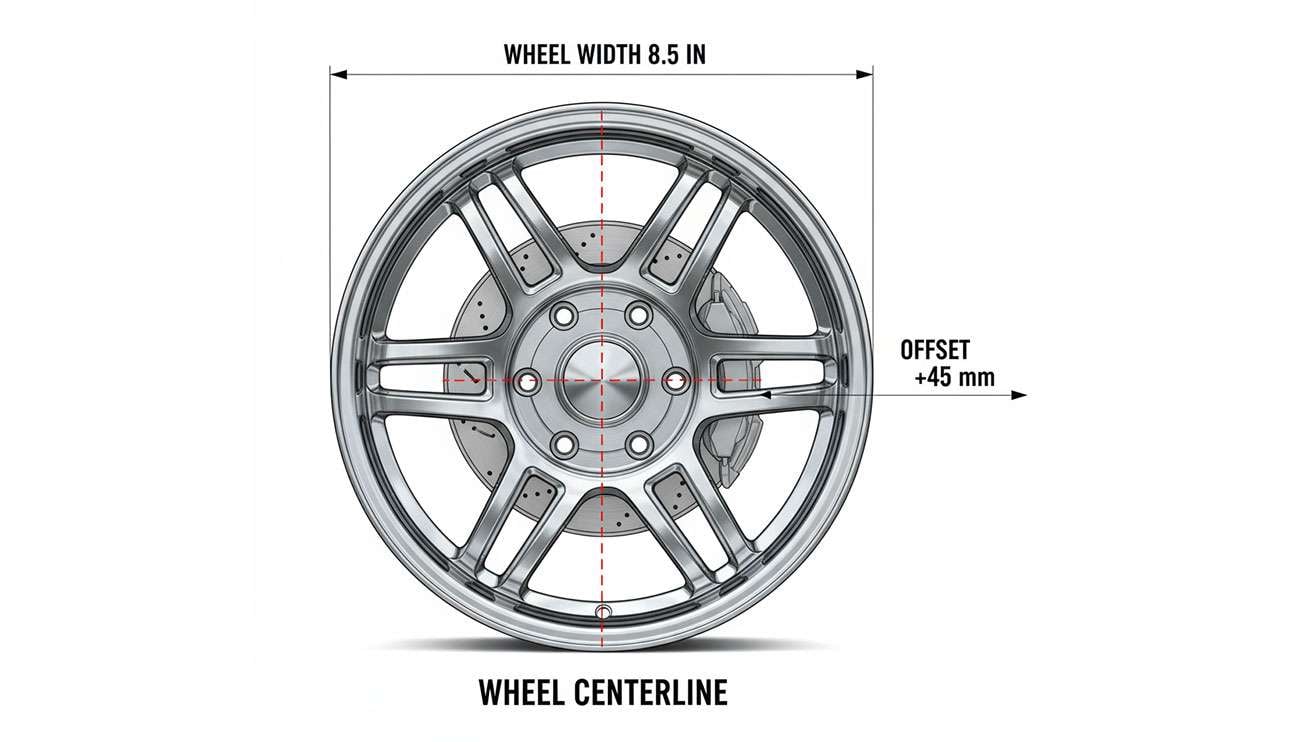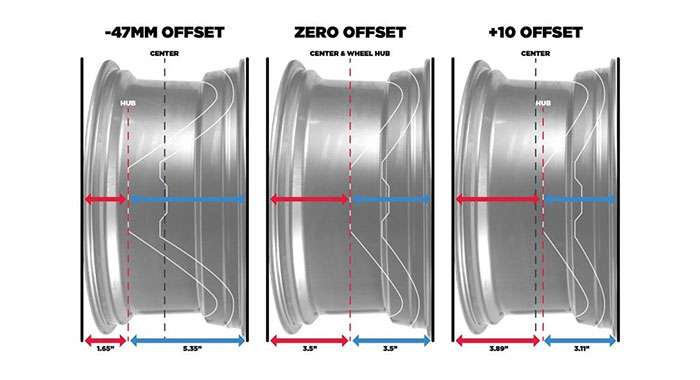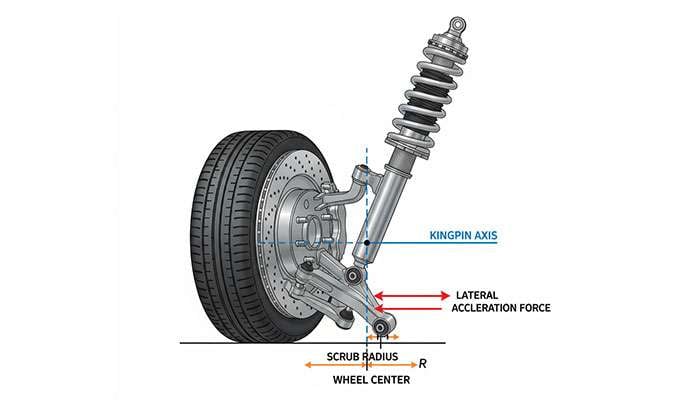
What does offset on wheels do? Wheel offset determines exactly where your wheels sit in relation to your vehicle's suspension and fenders, directly impacting both appearance and performance. The offset of a wheel is the distance from its hub mounting surface to the centerline of the wheel. Getting this measurement right means you'll achieve the wheel and tire combination that delivers the looks, handling, and safety you're looking for.
When it comes to wheel fitment, offset stands as one of the most critical measurements to understand. Offset and backspacing work together to determine your wheel's exact position. Wrong offset for your vehicle can seriously affect handling characteristics. Too much negative offset creates significant risks, including compromised handling and excessive stress on suspension components. Most wheel experts recommend staying within 5 millimeters of your original offset when installing new wheels.
Selecting the right wheel offset depends on several key factors, including your vehicle's specifications, wheel size, and tire dimensions. We'll guide you through everything you need to know about wheel offset, how it affects your vehicle's performance, and how to choose the perfect fitment for your specific setup.

Wheel offset represents one of the most important yet commonly misunderstood aspects of wheel fitment. Before you start shopping for new wheels, understanding this concept will help you avoid expensive mistakes and fitment problems.
Wheel offset is the distance (measured in millimeters) between the hub mounting surface and the wheel's centerline. Picture an invisible line running down the exact center of your wheel when you look at it from the side. The distance between that centerline and where your wheel bolts to the hub is your offset. This measurement controls where your wheel sits on your vehicle and influences everything from track width to suspension geometry.
You'll find this offset value stamped or engraved on the wheel, marked as "ET" (from the German word "Einpresstiefe," meaning "insertion depth") followed by a number. This single measurement determines how your wheels fit within your vehicle's wheel wells.
Three distinct types of wheel offset create different fitment characteristics:
Zero Offset: The hub mounting surface lines up perfectly with the wheel's centerline. This creates a balanced position where the wheel sits neither inward nor outward.
Positive Offset: The hub mounting surface sits toward the front or street-facing side of the wheel's centerline. This pushes the wheel closer to your suspension components and tucks it under the fender. Most front-wheel drive cars and newer rear-wheel drive vehicles use positive offset. Higher positive numbers push the wheel further underneath the car.
Negative Offset: The hub mounting surface positions toward the back half of the wheel (closer to the brake side). This moves the wheel outward away from the suspension, creating the classic "deep dish" look. Many rear-wheel drive vehicles and lifted trucks use negative offset wheels for a wider stance.
A +30mm offset means the wheel's mounting surface sits 30mm toward the front or street side of the centerline. The wheel will sit 30mm inward from a zero-offset position. When you switch from a factory wheel with +45mm offset to a +30mm offset, the wheel moves 15mm outward toward the fender.
This seemingly small measurement change creates dramatic differences in both appearance and performance. Most aftermarket wheels for certain vehicle models come in +38mm or +45mm offset options, even though factory specs sometimes reach +60mm.
Offset determines your wheel's exact position relative to your vehicle's suspension and body panels. Vehicle manufacturers calculate precise offset requirements to ensure optimal handling characteristics, suspension geometry, and tire clearance.
Changing your offset alters your vehicle's scrub radius—the point where the steering axis intersects the ground. Even small offset changes can significantly impact steering feel, suspension wear, and handling dynamics. Moving wheels outward with reduced offset increases leverage on steering components.
When you upgrade to wider wheels, offset typically must change proportionally to maintain proper clearances. A wider wheel with the same offset would add width equally to both inside and outside, potentially causing clearance problems with suspension components or fenders.

Wheel offset directly impacts your vehicle's performance beyond just appearance. The precise positioning of wheels affects everything from daily driving dynamics to high-speed stability.
Offset changes your vehicle's track width—the distance between wheels on the same axle. When you decrease offset by moving wheels outward, you create a wider stance that reduces lateral load transfer during cornering, potentially improving stability and grip. This relationship involves complex suspension dynamics that extend well beyond simple track width calculations.
Most importantly, offset changes affect your vehicle's scrub radius—the distance between the steering axis and the center of the tire's contact patch. Even a 5mm offset change noticeably alters your car's handling characteristics. The wheels no longer pivot perfectly around their center point but instead swing through a slight arc during steering input.
Positive scrub radius causes wheels to toe out under braking, while negative scrub radius makes them toe in. Proper offset maintains optimal suspension geometry by preserving the engineered relationship between steering axis and wheel centerline. Modern vehicles use sophisticated suspension designs that depend on specific offset ranges to maintain these critical geometrical relationships.
Yes, offset significantly affects brake performance and reduces strain on wheel bearings. During braking, offset determines how forces transmit through your suspension and steering components.
Excessive positive scrub radius created by improper offset makes steering unstable under braking. During hard stops, the uneven forces acting through the increased leverage point can pull the steering wheel from your hands. The weight of your vehicle pushes against this lever arm, creating a toe-in effect that might marginally reduce stopping distance—assuming you can maintain control of the steering wheel.
Wrong offset places additional stress on your entire suspension system. Moving wheels outward increases leverage on ball joints, control arms, and wheel bearings. This additional leverage accelerates wear on these critical components.
Consider this: a 10mm offset change translates to 10mm of wheel position adjustment, affecting everything from fender clearance to suspension geometry. Your suspension must compress differently to maintain tire contact with the road surface.
The engineering impact becomes particularly evident in front-wheel-drive vehicles. Many manufacturers use specialized front suspension designs to minimize unwanted steering effects, but incorrect offset can eliminate these benefits.
Negative offset pushes wheels outward from the vehicle, creating that aggressive stance many enthusiasts desire. Beyond appearance, negative offset produces tangible performance changes.
First, it increases track width, which can improve cornering stability. This wider stance reduces body roll during turns and enhances handling, especially at higher speeds. For trucks and off-road vehicles, this wider footprint provides increased stability on uneven terrain.
These benefits come with tradeoffs. The outward stance increases leverage on suspension joints and wheel bearings, accelerating wear rates. Additionally, wheels with negative offset are more exposed to damage from roadside obstacles. While negative offset offers visual appeal and some handling advantages, it requires careful consideration of the potential downsides to your vehicle's overall performance and component longevity.

Wheel offset dramatically changes your vehicle's visual presence on the road. The positioning of wheels within your fenders—or extending beyond them—creates distinct looks that automotive enthusiasts instantly recognize and appreciate.
Wheel offset controls how much of your wheel appears recessed or protruding from your fenders. Positive offset positions wheels deeper inside the wheel well, creating that tucked-in, understated look common on luxury sedans. As offset numbers decrease toward zero and into negative territory, the wheel face moves outward while pushing more of the wheel barrel inward. This creates the coveted "deep dish" look where you can see significant wheel depth.
High positive offset (+40mm and above) creates a conservative appearance with wheels sitting inward, visually narrowing your vehicle's stance. Lower positive offset (+15mm to +25mm) pulls wheels closer to the fender edge, delivering a more performance-oriented appearance. Negative offset wheels (-10mm to -44mm) create that eye-catching dish effect with wheels protruding outward, making vehicles appear wider and more aggressive.
These three distinct fitment styles represent the primary approaches in wheel customization:
Flush fitment positions wheels perfectly aligned with the fender edge—neither protruding nor recessed. This balanced look maximizes performance while remaining visually striking, making it the most sought-after setup for enthusiasts who want both form and function. Achieving true flush fitment requires precise offset calculations, as even millimeters of variance can shift the appearance.
Poke fitment occurs when wheels extend beyond the fender line, creating a bold, aggressive stance. Originally popular in drag racing for wider rear wheels that provided better grip, this style has become a signature look for muscle cars and modified trucks. While visually imposing, poke fitment often requires fender modifications to prevent rubbing issues.
Tucked fitment places wheels recessed behind the fender edge, making vehicles appear wider than their actual dimensions. This style typically uses higher offset wheels with flat profiles, often paired with lowered suspension or air ride systems. The tucked look creates a sleek, streamlined appearance that's particularly popular in European-inspired builds.
Consider a standard sedan with factory +45mm offset wheels. Switching to +30mm offset wheels effectively moves each wheel 15mm outward, creating 30mm of additional track width. This small change produces a noticeably more planted, aggressive stance without requiring bodywork modifications.
For trucks, moving from factory zero offset to -44mm creates that commanding off-road presence, though it's primarily suited for street or show builds focusing on looks rather than trail performance. SUV owners often find +0mm offset provides an ideal balance between aggressive appearance and practical performance for mixed on/off-road use.
Most modern performance cars use positive offset (+35mm to +60mm) from the factory. This conservative approach prioritizes clearance and reliability. However, enthusiasts frequently adopt more aggressive fitments, trading some function for the undeniable visual impact of a wider, more purposeful stance.
Wrong wheel offset creates serious mechanical problems that can damage your vehicle and compromise safety. These issues go far beyond appearance concerns and directly affect your vehicle's functionality and reliability.
Wrong wheel offset often causes tire rubbing against fenders, creating a dangerous driving situation. Too much negative offset pushes tires outward beyond fender boundaries, causing contact during turns or when hitting bumps. Maintaining at least an inch of clearance between tires and fenders prevents damage and ensures safe operation. Each time rubbing occurs, it cuts into your tire sidewall like a knife, potentially causing sudden tire failure or dangerous blowouts.
Wrong offset can cause wheels to contact brake components—a critical safety issue. Brake calipers need specific clearance, with manufacturers requiring minimum 0.100 inch clearance around the entire caliper. Heat expansion during braking can cause contact without proper clearance, potentially cracking rotors or damaging vital braking components. This interference gets worse as components wear, creating an increasingly dangerous situation.
Excessive negative offset puts extra strain on suspension parts. Ball joints, wheel bearings, and steering components experience accelerated wear from increased leverage created by improper wheel positioning. These components weren't designed to handle such stress, making premature failure likely. Symptoms often develop gradually until catastrophic failure occurs without warning.
Choosing the right wheel offset requires understanding key measurements and making informed calculations to achieve optimal fitment for your vehicle. Getting these fundamentals right ensures your wheels deliver both the performance and appearance you want.
Wheel offset markings appear as "ET" followed by a number, such as ET35, typically located on the wheel's inner barrel or spoke. This marking comes from the German word "Einpresstiefe," which represents the distance in millimeters from the hub mounting surface to the wheel's centerline. These markings tell you exactly how your wheel will sit relative to your suspension and fenders.
Factory wheels typically use higher positive offsets (+45 to +60mm) to ensure optimal handling and clearance. Aftermarket wheels often feature lower offsets for enhanced visual appeal, but this can sacrifice performance benefits. We recommend staying within 5mm of your factory offset when upgrading to maintain proper handling and reduce stress on components.
Online wheel offset calculators provide helpful preliminary guidance before you purchase new wheels. Input your current wheel specifications (width and offset) along with potential new wheel dimensions to visualize fitment changes. These tools calculate both inner clearance and outer position, helping you predict potential rubbing issues. However, actual test fitting remains the most reliable method for confirming proper clearance.
Backspacing measures from the wheel's inner lip to the mounting surface (typically in inches), while offset measures from the wheel centerline. Both measurements determine wheel position from different reference points. To convert offset to backspacing for positive offset wheels: (Wheel Width + 1)/2 + (offset × 0.03937). For negative offset: (Wheel Width + 1)/2 - (offset × 0.03937).
Visit performanceplustire.com for expert guidance on selecting the perfect wheel offset for your vehicle and browse our extensive collection of wheels with various offset options.
Wheel offset is one of the most important factors in achieving proper wheel fitment for your vehicle. Understanding how positive, zero, and negative offset affect both appearance and performance helps you make the right choice for your specific needs. When you get offset right, you'll achieve the perfect balance of style, handling, and safety.
Wrong offset can create serious problems for your vehicle. Tire rubbing, brake interference, and premature suspension wear are just some of the issues that come from improper fitment. That's why staying within 5mm of your factory specifications offers the best approach for maintaining optimal performance and avoiding costly repairs.
The visual impact of different offset choices can dramatically change your vehicle's appearance. Whether you want the aggressive stance of negative offset or the clean, tucked look of higher positive offset, your choice shapes how your vehicle looks and performs. These appearance changes also affect real-world handling through changes in track width and suspension geometry.
The best wheel offset balances your style goals with practical concerns about clearance, handling, and component life. Test fitting remains the most reliable way to confirm proper fitment, though offset calculators can provide helpful initial guidance.
At Performance Plus Tire, we understand the importance of getting wheel offset right. Our expert team can help you select the perfect offset for your vehicle and browse our extensive collection of wheels with proper fitment options. Our Custom Wheels page is a good place to start when you're ready to upgrade your ride.
Getting wheel offset right means achieving the look you want while maintaining the performance and safety your vehicle was designed for. With the knowledge from this guide, you can approach wheel upgrades with confidence, knowing exactly what offset numbers mean and how they'll affect your specific vehicle.
Understanding wheel offset is crucial for achieving the perfect balance between vehicle performance, safety, and esthetics when upgrading your wheels.
Wheel offset determines wheel position: Measured in millimeters from hub mounting surface to wheel centerline, affecting both appearance and handling dynamics.
Stay within 5mm of factory specs: Deviating more than 5mm from original offset can adversely affect handling and increase suspension component wear.
Wrong offset causes serious problems: Improper fitment leads to tire rubbing, brake caliper interference, and accelerated wear on ball joints and bearings.
Offset directly impacts performance: Changes alter scrub radius and track width, affecting steering feel, braking stability, and cornering characteristics.
Visual impact varies by offset type: Positive offset creates tucked appearance, zero offset provides balance, negative offset delivers aggressive "poke" stance.
Always test fit before purchasing: Use offset calculators for preliminary guidance, but physical test fitting remains the most reliable confirmation method.
Getting wheel offset right means achieving your desired look while maintaining optimal vehicle performance and avoiding costly mechanical issues down the road.
Wheel offset significantly impacts vehicle performance by altering the track width, scrub radius, and suspension geometry. It affects steering feel, cornering stability, and braking performance. Even small changes in offset can noticeably change handling characteristics, so it's important to stay close to factory specifications for optimal performance.
Positive offset means the wheel's mounting surface is closer to the outside face of the wheel, tucking it inward towards the suspension. Negative offset positions the mounting surface closer to the inside, pushing the wheel outward for a wider stance. Zero offset is when the mounting surface aligns with the wheel's centerline.
Yes, improper wheel offset can lead to several issues. It may cause tire rubbing against fenders, interference with brake components, and accelerated wear on suspension parts like ball joints and wheel bearings. These problems can compromise safety and lead to costly repairs if left unchecked.
To choose the right offset, start by checking your vehicle's factory specifications. It's generally safe to stay within 5mm of the original offset. Use online calculators for initial guidance, but always perform a physical test fit to ensure proper clearance. Consider both performance needs and desired esthetics when selecting offset.
The ET value, which stands for "Einpresstiefe" (insertion depth in German), represents the wheel's offset in millimeters. It's typically marked as "ET" followed by a number, such as ET35. This number indicates the distance from the wheel's mounting surface to its centerline, determining how the wheel sits in relation to the vehicle's body and suspension.